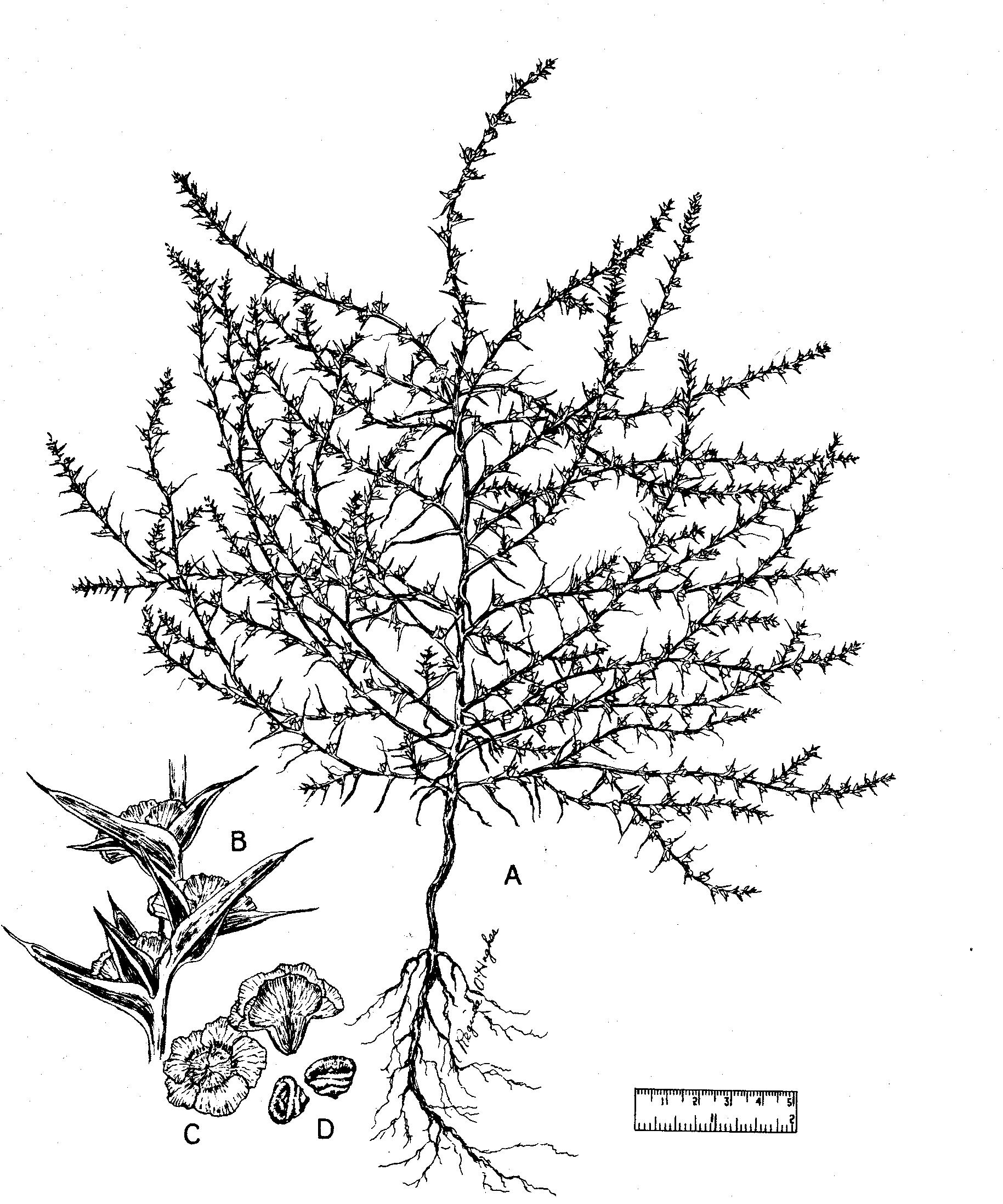Description
Synonymy- Until recently, the largely inland weed Salsola tragus (Russian Thistle) was frequently known as a subspecies of S. kali, ssp. tragus. The coastal plant S. kali (Saltwort) was known as S. k. ssp. kali (Kartesz 1994). Mosyakin (1996) distinguished the coastal S. tragus as a full species, separate from S. kali.
Taxonomy
| Kingdom | Phylum | Class | Order | Family | Genus |
|---|---|---|---|---|---|
| Plantae | Magnoliophyta | Magnoliopsida | Caryophyllales | Chenopodiaceae | Salsola |
Synonyms
Invasion History
Chesapeake Bay Status
| First Record | Population | Range | Introduction | Residency | Source Region | Native Region | Vectors |
|---|---|---|---|---|---|---|---|
| 1898 | Unknown | Unknown | Introduced | Boundary Resident | Europe | Eurasia | Agriculture(Agricultural Weed) |
History of Spread
Salsola tragus (Russian Thistle) is native to southeastern Europe and central Asia. While it is predominantly a plant of arid waste places, it also occurs in coastal and riparian sands. It may have been first introduced to North America in 1874 in SD, with contaminated flax seed from Russia, and swiftly spread through the west, where it is the most common species of wind-dispersed 'tumbleweed' (Mosyakin 1996). It has now been recorded from all U.S. states except AK and FL (Mosyakin 1996; Natural Resources Conservation Service 2001).
In coastal regions, this species may often be unrecognized due to its similarity with S. kali, of which it was once considered a subspecies. The extent of its abundance on East Coast beaches and saltmarshes is unclear, but at Fire Island NY, it was reported to outnumber S. kali (Dowhan and Rosza 1989).
In the Chesapeake Bay region, S. tragus was collected from Cape Henry VA in 1898 (U.S. National Herbarium collections). It was also found in chrome ore piles in Canton MD, adjacent to Baltimore Harbor (Reed 1964). In VA, recent records are from the Piedmont and Mountain regions of the watershed (Natural Resources Conservation Service 2001). This plant is likely to have been overlooked in Chesapeake Bay tidal wetlands, and its establishment is uncertain.
References- Dowhan and Rosza 1989; Mosyakin 1996; Reed 1964; Natural Resources Conservation Service 2001; U.S. National Herbarium collections
Invasion Comments
Ecology
Environmental Tolerances
| For Survival | For Reproduction | |||
|---|---|---|---|---|
| Minimum | Maximum | Minimum | Maximum | |
| Temperature (ºC) | ||||
| Salinity (‰) | 0.0 | 0.0 | ||
| Oxygen | ||||
| pH | ||||
| Salinity Range | fresh-poly |
Age and Growth
| Male | Female | |
|---|---|---|
| Minimum Adult Size (mm) | ||
| Typical Adult Size (mm) | ||
| Maximum Adult Size (mm) | ||
| Maximum Longevity (yrs) | ||
| Typical Longevity (yrs |
Reproduction
| Start | Peak | End | |
|---|---|---|---|
| Reproductive Season | |||
| Typical Number of Young Per Reproductive Event |
|||
| Sexuality Mode(s) | |||
| Mode(s) of Asexual Reproduction |
|||
| Fertilization Type(s) | |||
| More than One Reproduction Event per Year |
|||
| Reproductive Startegy | |||
| Egg/Seed Form |
Impacts
Economic Impacts in Chesapeake Bay
Salsola tragus (Russian Thistle) may occur in Chesapeake Bay tidal wetlands and beaches, its economic impacts are unknown. It appears to be a rare weed, limited to terrestrial environments in the watershed (Mosyakin 1996; Natural Resources Conservation Service 2001).
References- Mosyakin 1996; Natural Resources Conservation Service 2001
Economic Impacts Outside of Chesapeake Bay
Salsola tragus (Russian Thistle) is a major agricultural weed in the midwest and western US, competing with crops and replacing forage on rangelands with its prickly, inedible foliage (Agricultural Research Service 1971; Mosyakin 1996; Natural Resources Conservation Service 2001). The extent of its impacts on coastal and estuarine areas is not known.
References- Agricultural Research Service 1971; Mosyakin 1996; Natural Resources Conservation Service 2001
Ecological Impacts on Chesapeake Native Species
Salsola tragus (Russian Thistle) may occur in Chesapeake Bay tidal wetlands and beaches, but is likely to be overlooked because of its similarity with S. kali. Its impacts on native biota are unknown.
Ecological Impacts on Other Chesapeake Non-Native Species
Salsola tragus (Russian Thistle) may occur in Chesapeake Bay tidal wetlands and beaches, but is likely to be overlooked because of its similarity with S. kali. Competition between the two plants is possible, but has not been studied, to our knowledge. Its impacts on other exotic biota are unknown.
References
Brown, Melvin L.; Brown, Russell G. (1984) Herbaceous Plants of Maryland, , College Park. Pp.Dowhan, Joseph J.; Rozsa, Ron (1989) Flora of Fire Island, Suffolk County, New York, Bulletin of the Torrey Botanical Club 116: 265-282
Fernald, Merritt L. (1950) Gray's Manual of Botany, In: (Eds.) . , New York. Pp.
Gleason, Henry A. (1963) The new Britton and Brown illustrated flora of the northeastern United States and adjacent Canada, In: (Eds.) . , New York. Pp.
Gleason, Henry A.; Cronquist, Arthur (1991) Manual of vascular plants of northeastern United States and adjacent Canada, In: (Eds.) . , Bronx, New York. Pp.
Mosyakin, Sergei L. (1996) A taxonomic synopsis of the genus Salsola (Chenopodiaceae) in North America., Annals of the Missouri Botanical Garden 83: 387-395
1997-2024 USDA PLANTS Database.. Onine databse
